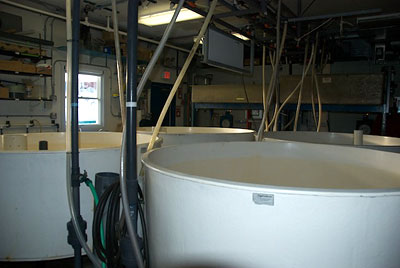|
|
Journals 2008/2009
Megan O'Neill
Fairhope High School, Fairhope, Alabama
April 30, 2009
Lab Setup and Weather Information
I started off the day getting my “land legs” back and getting a run in on the treadmill first thing. Such a great workout facility! Every piece of equipment and weights needed are there. Then I joined in the morning yoga group in the lounge that starts at 7:15 a.m. It is helpful to be limber to avoid injuries around here dealing with the snow and ice! The group has gotten a great series of yogadownload.com workouts that have slide pictures of poses and a great description of the poses as you go through it. My yoga group at home will be so proud. I have to admit the condition known as “dock rock” (coming off of several days of being on a rocking boat) made some of the poses a little difficult – at least that is my excuse!
Thankfully we were working in the lab today preparing for tomorrow’s fish dissections, because the weather outside was gray, snowing and very windy. Gusts were getting up to 38 knots and the sustained winds were around 25 knots. The temperature was forecasted for -4°C/25°F and the wind chill of -17°C/1°F! Our sunrise is 8:21a.m. and the sunset 4:05 p.m., although not much of was seen through the clouds! As I checked out the weather forecast on our handy Palmer Station website (www.palmer.usap.gov), I found some interesting tidbits of information about wind chill that I wanted to share:
|
What is the Wind Chill Factor?
The wind chill factor or wind chill index is a number, which expresses the cooling effect or moving air at different temperatures. It indicates in a very general way how many calories of heat are carried away from the surface of the body.
Who is associated with developing the concept of wind chill?
The Antarctic explorer, Paul A. Siple coined the term in his dissertation "Adaptation of the Explorer to the Climate of Antarctica," submitted in 1939. Siple was the youngest member of Admiral Byrd's Antarctica expedition in 1928-1930 and later made other trips to the Antarctic as part of Byrd's staff and for the United States Department of the Interior assigned to the United States Antarctic Expedition. He also served in many other endeavors related to the study of cold climates.
How is the wind chill index calculated?
Scientists have devised an equivalent temperature scale which makes it easy to determine the wind chill factor. Wind chill factors are supposed to measure the effect of the combination of wind speed and temperature upon human comfort. There is nothing "exact about windchill. It is an estimation of apparent temperature. It is important to remember that these do not have the same effect on inanimate objects, or even on other animals or on plants. Nor is this effect felt by humans who are sheltered from the wind.
The following formula is one of several that can be used to calculate wind chill:
Wind chill = 91.4 - (0.474677 - 0.020425 * W + 0.303107 * SQRT(W)) * (91.4 - T)
where W = wind speed (mph) & T = temperature (°F)
|
 |
Aquarium Room in lab |
|
|



